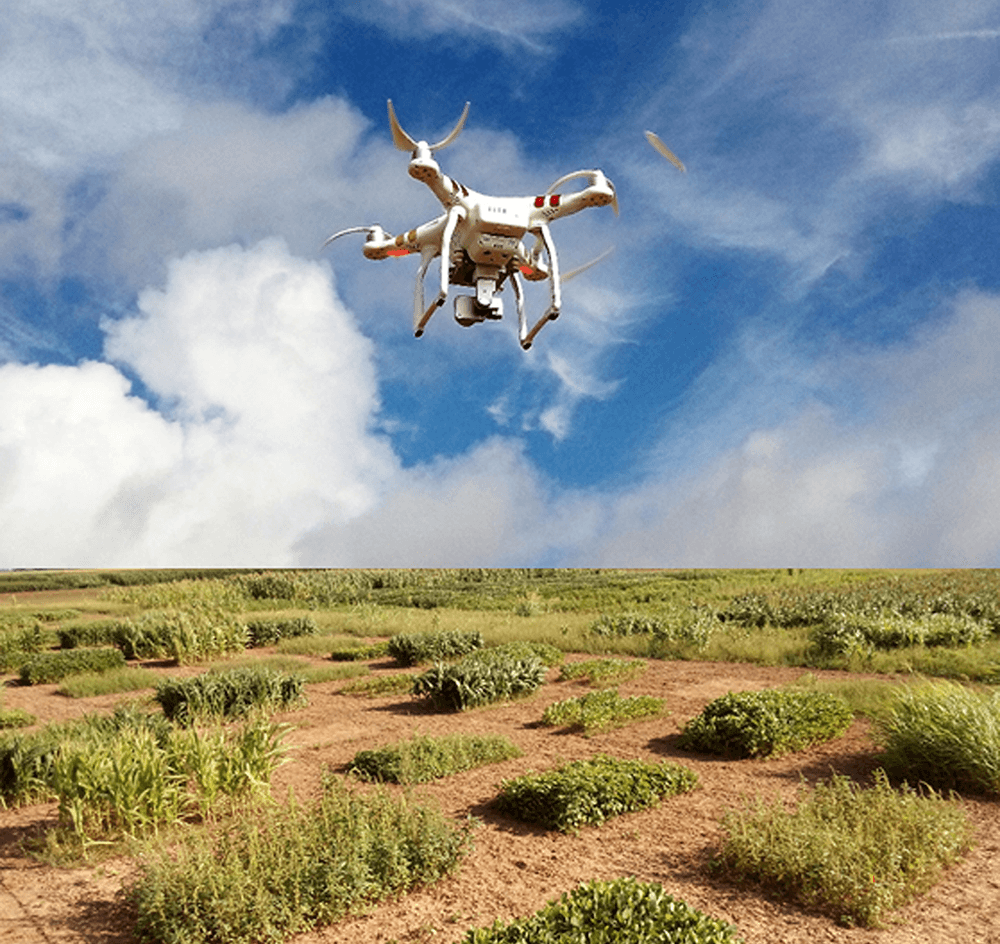
Even barely poking through the ground, weeds are distinctive. Determining the right tools for early identification and control are the goals of an ongoing Texas A&M AgriLife Research project.
Dr. Muthu Bagavathiannan, AgriLife Research weed scientist in College Station, is using unmanned aerial vehicles, or UAVs, to “read the weeds.”
“Our goal is to use advanced sensor technology to detect weeds from above the ground and implement precision weed management,” Bagavathiannan said.
The current practice is to have field scouts walk the large fields to look for weed issues, he explained. This is a tedious, time-consuming task that can be inaccurate, and bad weather conditions can prevent timely assessments of weed problems.
“But the UAV technology would provide the ability to fly over large fields and collect reliable information in a short time period that can be directly relayed into actionable information,” Bagavathiannan said. “We need this technology to make that identification sooner than the naked eye can.”
Targeted application
“The ultimate goal is to identify the weed species, the areas of the field they appear and in what densities so precision herbicide applications can be made or a herbicide program developed that better suits what is in the field,” said Dr. Vijay Singh, AgriLife Research assistant research scientist working with Bagavathiannan in College Station. “Geotagged maps would allow coordinates to be fed to a ground vehicle or an aerial applicator to treat specific areas.”
Members of the Texas A&M team that Bagavathiannan works with in College Station, among others, includes Dr. Nithya Rajan, AgriLife Research crop physiologist; Drs. Michael Bishop and Anthony Philippi at the Center for Geospatial Sciences, Applications and Technology, or GEOSAT; and Dr. Dale Cope, associate professor in the department of mechanical engineering.
The GEOSAT scientists are creating algorithms and indices that can one day be used by crop consultants to help producers identify weeds earlier, achieve greater control and use less chemical overall, thus be more economical and environmentally friendly.
“Putting this information into the hands of a consultant will be more cost-effective, as they can fly multiple fields in a short time,” Bagavathiannan said.
“We started working on weed and crop species differentiation in 2015 and over the past two years, we’ve collected a good amount of preliminary data to be able to look at images and conduct analysis,” he said.
The project is not without its challenges, though, Bagavathiannan said.
Rotary versus fixed wing
“We have to be able to detect weeds when they are very small and treatable, and that is only achievable by flying very low or using very high resolution cameras,” Singh said. “We have found the rotary wing aircraft to be more useful than fixed wing, because they can hover at lower altitudes and perform agile maneuvering, which makes them well suited for field inspections.”
For instance, he said the current cameras are able to achieve a pixel size of 2 centimeters, but a size of a few millimeters is ideal for capturing more details of the weed and accurate identification.
Singh said a simple RGB image analysis was sufficient to differentiate some weeds, such as morning glories, devil’s claw and cocklebur, which can be done based on color, shape and textural features. They are also using multispectral and hyperspectral imagery, both useful in distinguishing several species.
“Hyperspectral imagery can pick up differences among weeds even at a distance,” Bagavathiannan said.
They are currently developing a spectral library for different weeds using the high-end hyperspectral spectroradiometer available with Rajan.
“It can be difficult for the untrained eye to tell the difference between the pigweed species Palmer amaranth and waterhemp, but using hyperspectral, we can look at the spectral waves for differences; a wide band in the water region may indicate one over another,” Bagavathiannan said.
No one-size-fits-all fix
“The challenge will be in a stress situation such as drought, because that can influence the results you get,” Rajan said. “That’s why we need more intensive research to understand the influence of all these interacting factors.”
It is also possible to use multi-temporal remote sensing and thermal cameras to create a temperature map to identify different weed species as they may have different thermal signatures, Bagavathiannan added.
Other tools to incorporate are spatial information and knowledge integration.
“Each weed species has a specific structure and infestations have specific spatial features, which could be used to create algorithms for weed detection in the field,” said Bishop. “Also, certain weeds occur only at certain times of the year and that information can be integrated into the models.”
Bagavathiannan said weed detection is complex and there is no one-size-fits-all type solution.
“We may have to use more than one tool or employ all the tools together to achieve our goal,” he said. “At this point we are generating a database of critical fundamental information about weed species characteristics. Ultimately we will be able to develop cost-effective technology.”
###
This story by Kay Ledbetter originally appeared in AgriLife Today.



